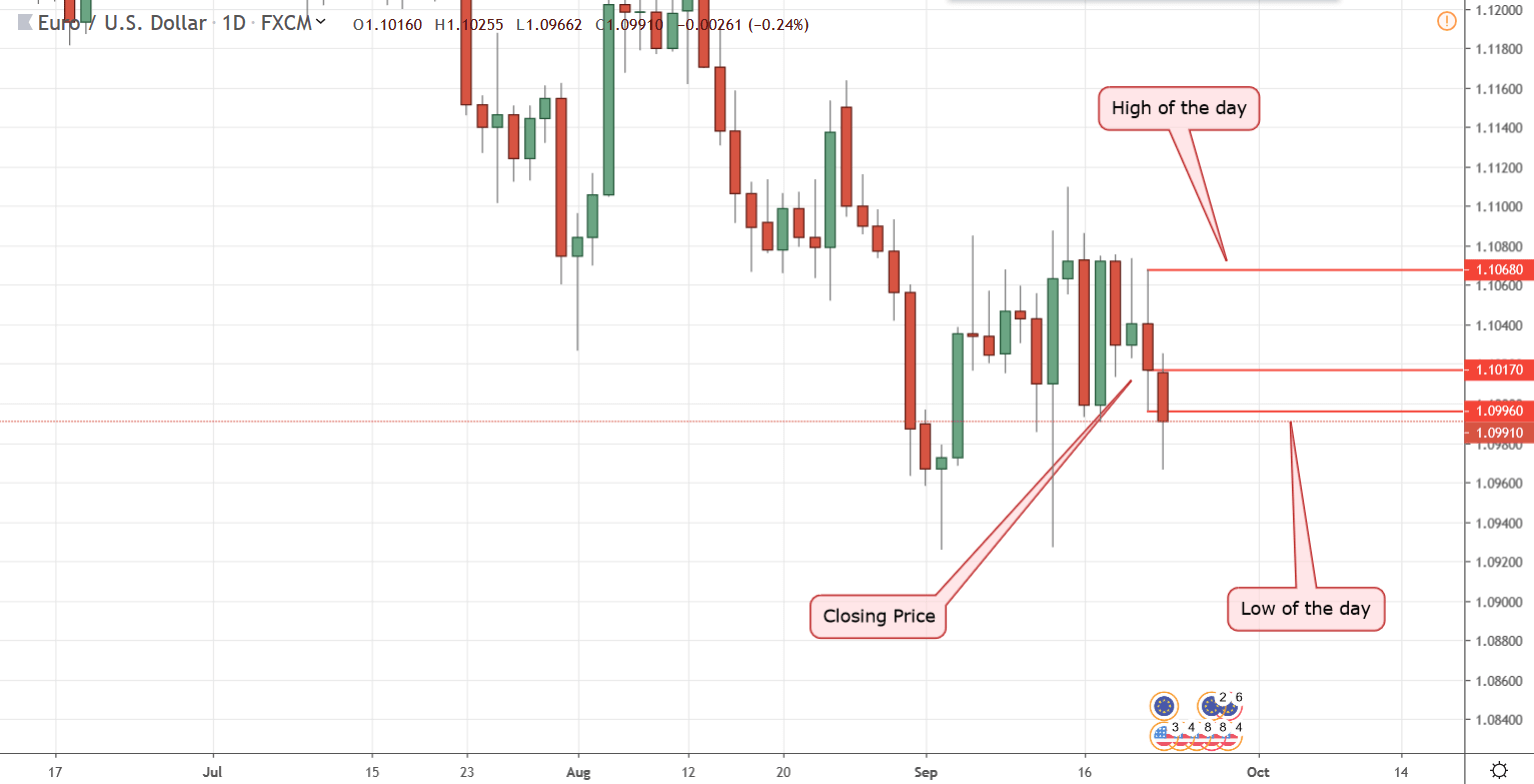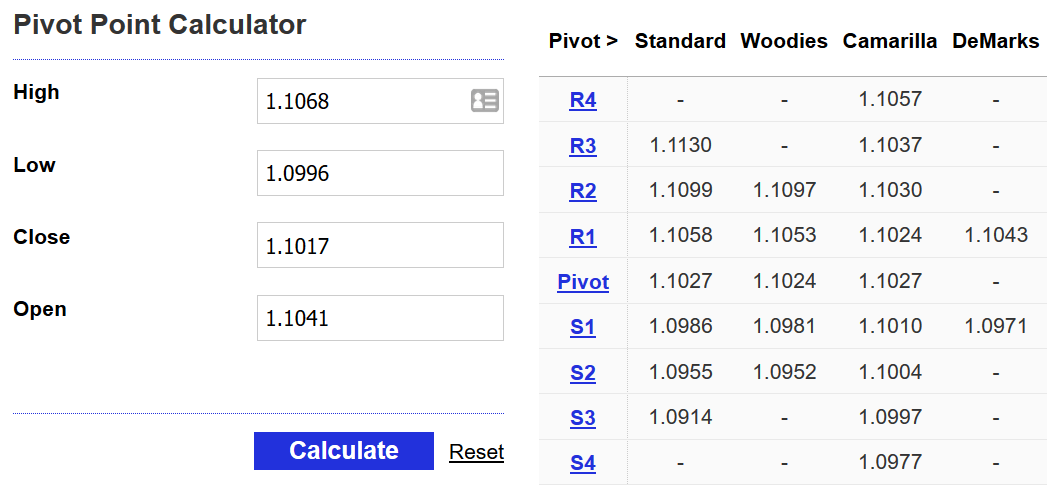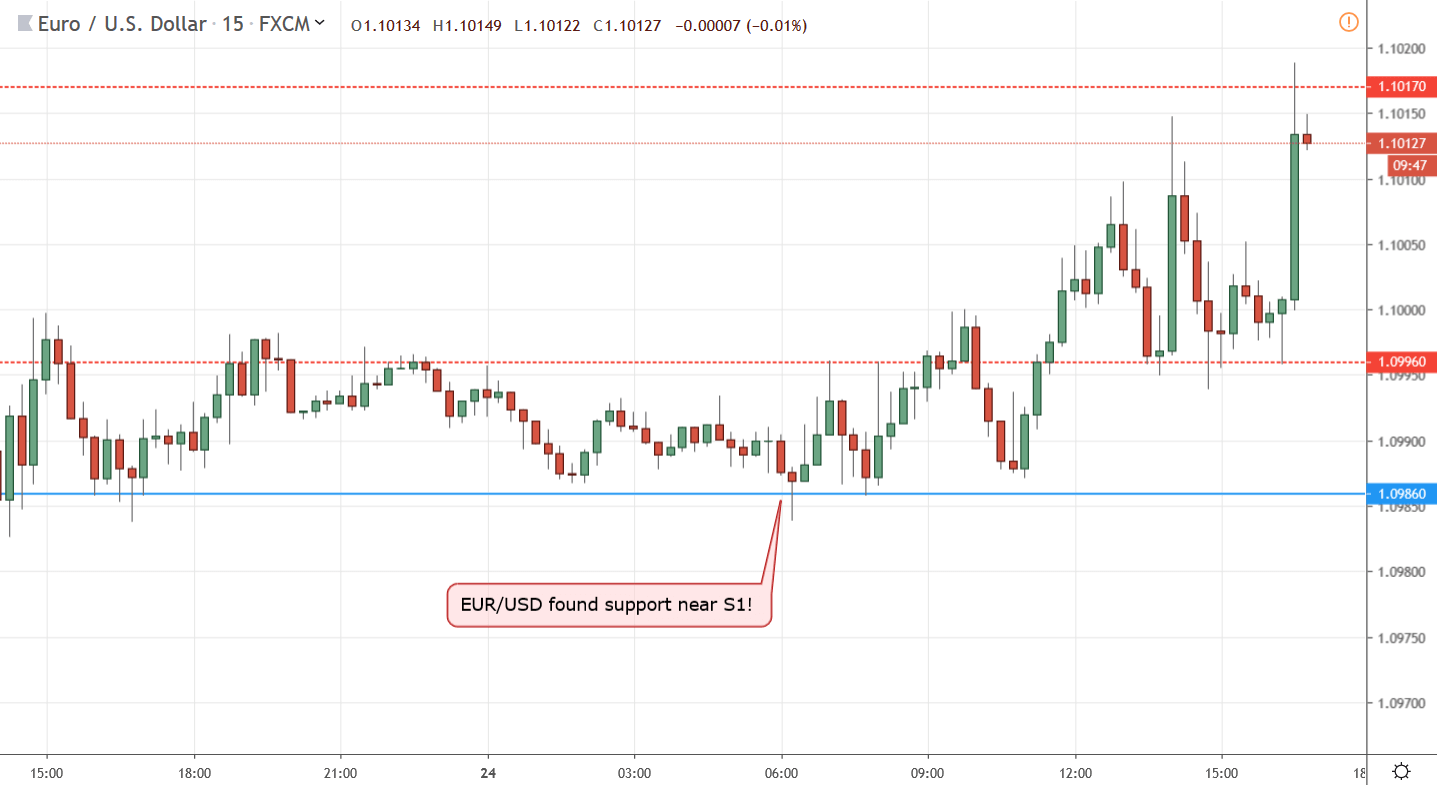How to Use ForexChurch Pivot Point Calculator to Be in Sync with Smart Money
Pivot points, as the name suggests, are anchoring points drawn on a price chart to represent where the directional movement of a currency pair might turn back or continue. These are the areas of interest that the majority of floor trader watch on a daily basis to gauge the overall sentiment in the market.
Pivot points are drawn as horizontal lines on charts to represent potential support and resistance levels that the asset of the price might encounter in the future. But unlike Fibonacci levels, pivot points are not based on a percentage of a high and low point in a given timeframe. These are calculated based on the previous day's high, low, and closing prices. Hence, regardless which type of trader you are - be it a day trader or a longer-term swing trader, or which time frame you are trading, or where you are located - if you are using daily pivot points, the levels will be always same.
Above and below the main pivot point, there are few other levels that act as potential support and resistance levels and these are identified as Support 1 (S1), Support 2 (S2), Resistance 1 (R1) and Resistance (R2). Some traders go on to draw the third level of support and resistances, which are labeled as Support 3 (S3) and Resistance 3 (R3).
We can simply draw horizontal lines on a chart to represent the pivot points, including the three support and resistance levels. Treating these as potential support and resistance levels is one way to go about it. However, there are more sophisticated ways you can use pivot points in your daily trading that we will discuss in a bit. Before that, let's discuss what makes pivot points unique and why you should consider building a trading strategy around these levels.
- Why You Should Use Pivot Points in Forex Trading
- There are Different Ways to Calculate Pivot Points
- How to Calculate Different Types of Pivot Points
- How to Calculate Standard Pivot Points
- How to Calculate Woodie's Pivot Points
- How to Calculate Camarilla Pivot Points
- How to Calculate DeMarks Pivot Points
- Which Pivot Point is Better?
- How to Use ForexChurch Pivot Point Calculator
- The Bottom Line
Why You Should Use Pivot Points in Forex Trading
Unless you are a novice Forex trader, you have probably heard about the concept of self-fulfilling prophecy. A perfect example of a self-fulfilling prophecy would be: if most traders believe the price would go up and bid up the price, the price ends up going - you guessed it right - up.
In the nutshell, regardless of the origins of pivot points, it works in Forex trading because professional traders keep an eye on these levels. Since the "smart money" base trading decisions in terms of where the price is in relation to pivot points, the market ultimately respects these levels and the circle of self-fulfilling prophecy is complete.
Once the price goes below the pivot point during a day, institutional money managers and professional traders with large funds at their disposal start to consider the market to be bearish and place their orders accordingly. Hence, once the price comes near to Support 1 (S1), it triggers a barrage of pending sell orders, and the more bearish momentum is created. On the other hand, if enough buy orders are placed at Resistance 1 (R1), it would create the opposite effects and bullish momentum would be accelerated.
Nonetheless, if the price is hovering way below Support 3 (S3) or above Resistance 3 (R3), the majority of professional traders might consider it to be way out of equilibrium and start to reverse their action, causing retracements in the market.
The point is, regardless of which way the market would react, they often react around the pivot points. As these are areas of confluence, knowing where the pivot points are located on a chart can help you magnify your perception about the direction of the market and improve your win rate. Because entering the market after the price has broken out of major support or resistance would always help you ride the momentum better.
Moreover, knowing where the daily pivot points are on a chart can aid in your money management strategy and reduce the size of your stop-loss. Just imagine, if you knew that the S1 is only 15 pips away and you got a buy signal, you can easily reduce your standard stop loss to 18, to accommodate spreads - of course, instead of risking more pips than needed!
That's why pivot points are such an important part of day trading as it can put your trading strategy on steroids in terms of finding direction and improving your money management.
There are Different Ways to Calculate Pivot Points
There are several different variants of pivot points, but they all rely on the same principle. The only difference is how they are calculated. Some of the most popular variants are:
- Standard
- Woodie's
- Camarilla
- DeMarks
All four of the pivot points variants can be calculated using the ForexChurch PP Calculator.
How to Calculate Different Types of Pivot Points
While the first three pivot points use the previous day's high, low, and closing prices, only the DeMarks pivot points need the opening prices to calculate it.
How to Calculate Standard Pivot Points
The simplest pivot points are called Standard or Classic pivot points. These are calculated based on the average of the high, low, and closing prices of a timeframe, which is often based on the previous day's numbers.
To calculate, the standard pivot points, you need to sum up the high, low, and closing prices and divide it by three. Hence, the formula would be:
Pivot point (PP) = (High + Low + Close) / 3

In figure 1, we can see the EUR/USD's High, Low, and Closing prices of the previous day's candlestick. Using the formula stated above, the pivot point for the next day would be:
(1.1068 + 1.0996 + 1.1017) / 3 = 1.1027
Once you have your pivot point, it is time to calculate the corresponding support and resistance levels.
The formula for S1, S2, S3 and R1, R2, R3 are the following:
Support 1 (S1) = (2 x Pivot Point) - High
= (2 x 1.1027) - 1.1068 = 1.0986
Support 2 (S2) = Pivot Point - (High - Low)
= 1.1027 - (1.1068 - 1.0996) = 1.0955
Support 3 (S3) = Low - 2(High - Pivot Point)
= 1.0996 - 2(1.1068 - 1.1027) = 1.0914
Resistance 1 (R1) = (2 x Pivot Point) - Low
= (2 x 1.1027) - 1.0996 = 1.1058
Resistance 2 (R2) = Pivot Point + (High- Low)
= 1.1027 + (1.1068 - 1.0996) = 1.1099
Resistance 3 (R3) = High + 2(Pivot Point - Low)
= 1.1068 + 2(1.1027 - 1.0996) = 1.1130

How to Calculate Woodie's Pivot Points
The formula for calculating the Woodie's pivot point is the following:
Pivot Point = (High + Low) + (2 x Close Price) / 4
Support 1 (S1) = (2 X Pivot Point) - High
Support 2 (S2) = Pivot Point - (High + Low)
Resistance 1 (R1) = Pivot Point + (High - Low)
Resistance 2 (R2) = (2 X Pivot Point) - Low
Please note that the Woodie's pivot point only calculates two levels of support and resistances compared to the three levels found in the standard version.
How to Calculate Camarilla Pivot Points
Pivot Point = (High + Low + Closing) / 3
Support 1 (S1) = Closing - ((High -Low) x 1.0833)
Support 2 (S2) = Closing Price - ((High -Low) x 1.1666)
Support 3 (S3) = Closing Price - ((High -Low) x 1.2500)
Support 4 (S4) = Closing Price - ((High-Low) x 1.5000)
Resistance 1 (R1) = Closing Price + ((High - Low x 1.0833)
Resistance 2 (R2) = Closing Price + ((High - Low) x 1.1666)
Resistance 3 (R3) = Closing Price + ((High - Low) x 1.2500)
Resistance 4 (R4) = Closing Price + ((High - Low) x 1.5000)
Camarilla pivot points use four levels of support and resistance to anticipate potential reversal points during a day. Floor traders consider the market to be circular in nature as prices usually go up or down, then retrace before continuing the trend. With Camarilla pivot points, if you use S4 and R4 as your standard stop-loss for uptrend and downtrend, respectively. However, if you see the price going above or below the fourth level of support or resistance, it would signal a strong trend in the market, and you should resort to applying a momentum-based trend following strategy.
How to Calculate DeMarks Pivot Points
Among the four, only DeMarks pivot points use opening prices to measure the pivot levels. In fact, the whole approach of Thomas DeMark, who is the founder and CEO of DeMark Analytics, LLC and developed this unique pivot point formula in the 1980s, is very different to the standard variant.
To calculate the DeMarks pivot points, you first need to identify if the opening price is above, below, or equal to the closing price. Depending on the closing price in relation to the opening price, you need to calculate a placeholder value. To simplify, let's assume this placeholder is X.
To find X, either of the following three formulas will apply:
If the closing price is higher than the opening price, then DeMarks X would be:
(2 x High) + Low + Close
If the closing price is lower than the opening price, then DeMarks X would be:
High + (2 x Low) + Close
If the Closing price is equal to the opening price, then DeMarks X would be:
High + Low + (2 x Close)
Once you have the value of X, calculating the pivot point is rather easy, as you just need to divide the value by four.
So, DeMarks Pivot Point = X / 4
DeMarks pivot points only have one support and one resistance levels and the formulas for calculating these are the following:
Support 1 (S1) = X / 2 - High
Which Pivot Point is Better?
The different calculation formulas for these four variants of pivot points prioritize different values. Thus, using one over another will give more or less weight to certain values. For example, the Woodie's formula multiplies the closing price by 2, and as a result, the output figures put more weight on the closing price. Since closing price is the last value of a candlestick or bar, it emphasizes more on recent data than the high or low prices. On the other hand, the Standard version averages all three values, giving equal weight to all. By contrast, the DeMarks pivot points incorporate the opening price and the calculation might look more sophisticated as it takes the relationship between opening and closing prices.
You might be wondering which type of pivot point calculator is better and offers the best support and resistance levels to watch during a trading day. Before we delve into that minefield of a question, let's try to recap why pivot points work as we discussed above.
Since pivot points work because of the concept of self-fulfilling prophecy, it is common sense that whichever pivot point formula is used by most floor traders and professional investors would be the most effective one. Since the majority of the market participants use the Standard formula to calculate pivot points, using the Standard pivot points would help identify the most effective areas of confluence in day trading and yield the best results.
However, if you can successfully integrate other types of pivot points into your trading strategy that matches those levels closely, it might be better to stick to those instead of using the Standard pivot points.
How to Use ForexChurch Pivot Point Calculator
As you can guess by now, manually calculating pivot point with a handheld calculator or even spreadsheets can be a tedious chore that you have to repeat every day. Instead of going through the hassle of calculating pivot points manually, you can simply use the ForexChurch pivot point calculator to save time and effort.
The ForexChurch PP Calculator is easy to use and gives you the output of S1-S3 and R1-R3, as well as all the levels in the other three types of pivot points: Woodie's, Camarilla, and DeMarks. All you need to do is input the High, Low, Closing, and Opening prices of the previous day and with a click of a button, you can get all the outputs in a text format. Once you have the output, you can simply draw horizontal lines by copy-pasting the values you need for S1 or R3. No need to go through the hassle of manually inputting all the number in the R2 calculator to find the R2 value!

In figure 3, you can see a screenshot of the ForexChurch pivot point calculator. We have populated the input fields - the high, low, close and open - with the EUR/USD candle's data that we discussed earlier.
As you can see in the table on the right, once you click the calculate button (blue), it will display all the pivot points as well as the support and resistance levels for the four different variants of pivot points.
Once you have the pivot point output, you simply copy-paste the numbers and add several horizontal lines your price chart.
Once you have your Pivot point, S1, S2... and R1, R2... lines on the chart, which are calculated based on yesterday's daily bar, go down to a smaller timeframe like the 60-minute or 5-minute chart for Intraday trading.
At this point, you can trade any currency pairs as you would regularly do with your technical trading strategy. However, now you can incorporate the pivot point values to identify potential areas of support and resistance; and plan your trades accordingly.

If you still have doubts about how effective pivot points are, take a look at figure 4 that shows how the EUR/USD price reacted when it fell near the S1 level. On the 15-minute chart, we can clearly see that the EUR/USD tested the 1.0986 level several times, failing to do so and moving up in the process.
If your trading strategy produced a buy signal near the S1, you could have gotten away with setting a very tight stop loss and increased your reward to risk ratio on that trade if you were keeping an eye on the standard pivot points.
The Bottom Line
Besides the four pivot points we discussed, there are several other variants, such as the Fibonacci pivot point that you can use. However, as we discussed earlier, the point of using pivot points is to be in sync with floor traders and institutional investors. Hence, sticking to the most popular version of the pivot point calculations will end up working better than the obscure one.
If you are just starting out as a Forex trader, it would be better to stick to the Standard pivot points as it is the most widely used variant.
By using the ForexChurch Pivot Point calculator, you can eliminate the hassle of manually calculating these numbers with a calculator and streamline the process. At the same time, it will help you to focus on the actual task of trading.










